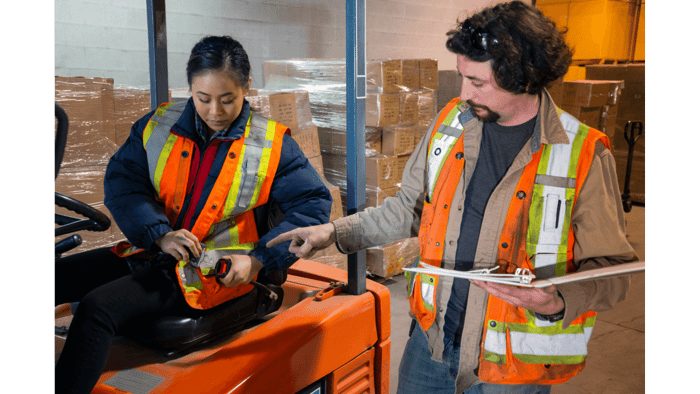No Products in the Cart

To watch this episode, click here.
On today’s episode, we’ll be covering making sure you’re being safe while operating Forklifts.
You’ll notice the title of our episode today is “Eyes Up Forks Down”. If you don’t know what we mean by forks, we’re referring to the forks on a Forklift.
Forklifts (also referred to as tow motors or lift trucks) almost always require some sort of training and certification before operating. Or at least they should. Regardless, here are few tips that’ll greatly increase your chances of keeping yourself, your staff, and the equipment you’re operating as safe as possible.
Before even getting on a forklift for the first time within a shift, do a safety check of the vehicle to make sure the wheels are in good condition and free of debris, that there aren’t any leaks, that fuel or battery power are good, and that everything appears to be in good working order. If something is out of place beyond the battery or fuel, be sure to alert management.
When we say, "Keep your eyes up", we mean pay close attention to your surroundings (especially blind spots).
Forks down should be interpreted just as it sounds. Unlike operating other machinery, with a forklift, you literally have forks in front of you. Whenever you’re not unloading or lifting a load, be sure to have your forks as low to the ground as possible to avoid hitting someone or something.
In addition to the forks, much of the time you’ll have items on them. Make sure you’re always able to see around the load you’re carrying, and have it as secure as possible.
You should always be mindful of your speed when operating any vehicle, but when you have a load, it’s especially important to maintain a safe speed.
You never want to do a hard brake when carrying a load, as it could fly off your forks or shift forward, causing damage or injury.
Sound your horn to let everyone know you’re coming and remember to give people on foot the right of way.
We mentioned checking your wheels to assure they’re in good condition and free of debris, and you’ll need to do the same for the areas you’re driving on. Be sure to watch for wet, slick, and debris-covered areas.
If the vehicle you’re on has seat belts or harnesses, be sure to wear them. Many injuries sustained by lift truck operators are from being thrown off and crushed by the vehicle they’re operating.
Don’t travel in areas you’re not supposed to be in.
There are many other rules you could follow, but these will help you on your way to safely operating forklifts at your facility.
Thank you for listening to Warehouse Safety Tips – and have SAFE day!
If you’re a seasoned Podcast Listener – this podcast is going to be different from most you listen to. It’s based around exactly what the name implies – Warehouse Safety Tips. And since the people in this industry are busy, we understand that time is money. Because of this, each episode will be as short and to the point as possible. You can find the show notes to each episode, links to information mentioned on the podcast, the social media platforms we’re on, and anything else related to the podcast at WarehouseSafteyTips.com
If you’ve ever been to or worked in a warehouse – you know just how important safety is to both management and staff. It’s almost impossible to go 10 steps without seeing Safety Tape, Angles, Signs, and/or products.
It’s these items that show us how to be safe and avoid danger in the workplace. And if you’re looking for the best products to make this happen – look no further than Mighty Line!
Mighty Line Floor Signs / Floor Markings offer the best industrial products out there!
Go to MightyLineTape.com/SafetyTips to request a Sample Pack of their incredible Safety Signs and Floor Markings.
Again – Go to MightyLineTape.com/SafetyTips to request a Sample Pack of their incredible Safety Signs and Floor Markings.